Do Plants Breathe?
By Jennifer L. Maeng and Amanda Gonczi
The idea that plants do photosynthesis but do not do cellular respiration is a common misconception among middle and high school students that often stems from an over-simplification of these processes in diagrams and formal science instruction. The activity presented here uses a conceptual change approach (Nussbaum & Novick, 1982) and an online simulation to facilitate high school students’ accurate conceptions of the relationship between photosynthesis and cellular respiration in plants.
“Plants do photosynthesis and animals do cellular respiration.” At some point in our science classes many of us have had this statement uttered to us by a teacher or said it to help students remember one of the key distinctions between plants and animals. In fact, research suggests many middle and high school students retain the prevalent misconception that plants transform energy through photosynthesis alone and do not engage in cellular respiration (Driver et al. 1994). Common representations of these processes and how gas exchanges between plants and animals, such as those in Figure 1, also reinforce this misconception.
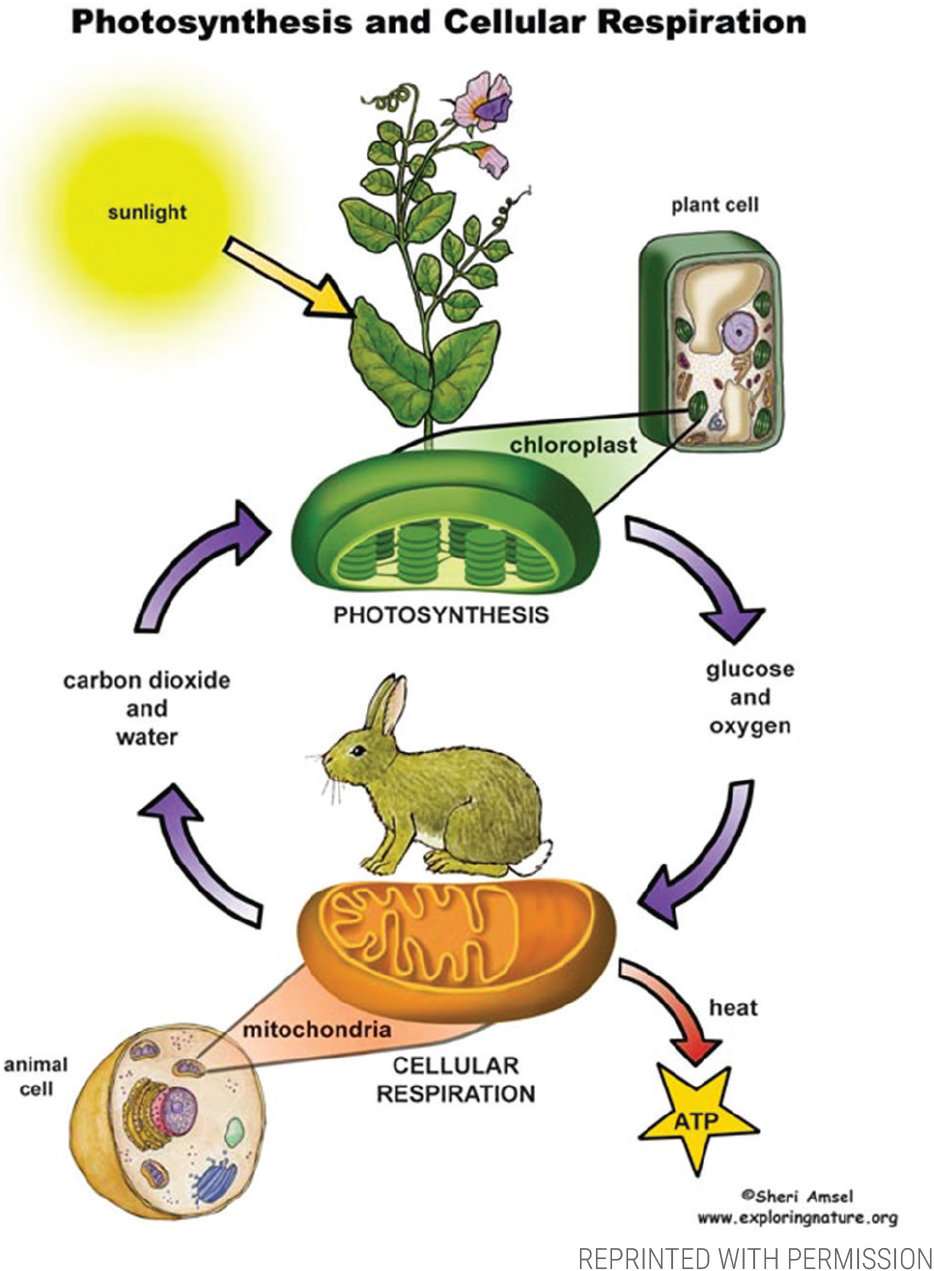
While scientists often describe energy production in plants and animals as making energy, it is important for students to understand that this does not mean that energy is created from nothing (i.e., a violation of the First Law of Thermodynamics). Rather, energy in systems is transformed from one form (e.g., sunlight) to another (e.g., chemical potential energy in the bonds of carbohydrate molecules such as glucose). Below, we use the phrase “make energy” when posing the research question to students because they are accustomed to this common language. However, teachers should ensure their students understand that in science “make energy” actually means “transform” energy.
The activity presented here uses a conceptual change approach (Nussbaum and Novick 1982) and an online simulation to facilitate high school students’ understanding of the relationship between photosynthesis and cellular respiration in plants. Conceptual change can be thought of simply as “unlearning to relearn.” A conceptual change approach is characterized by four key instructional features: revealing students’ preconceptions about a topic or phenomenon discussing and evaluating preconceptions creating conceptual conflict with preconceptions guiding conceptual restructuring
We purposefully used a computer simulation for this lesson, rather than the classic hands-on investigation, because computer simulations can be more effective in supporting conceptual change than hands-on activities (Ronen and Eliahu 2000; Trundle and Bell 2010). Computer simulations allow students to collect idea-challenging data sets quickly, repeatedly, and reliably. When physical equipment is used, there are many opportunities for error that may affect the accuracy of student data and the potential for the data to support conceptual change. In this lesson, the computer simulation supports student engagement in science content and important practices while developing data sets that reliably promote cognitive conflict.
Activating prior knowledge
This activity takes approximately one 90-minute class period, with students working in groups of three or four. We begin the lesson with a ball toss activity, throwing a soft ball to a student and asking him or her to provide one possible answer to the question: “What do we need energy for?” After responding, the student who catches the ball then tosses it to someone else in the class to answer the same question. Responses typically include: blinking, catching the ball, breathing, speaking, digesting, smiling, eating, laughing, and sitting.
Revealing, discussing, and evaluating students’ preconceptions
In this step, the goal is to help students make their existing conceptions about a topic explicit so that they become aware of their own ideas and thinking. We ask students to complete a simple pre-assessment individually (Figure 2, p. 29). It is important to emphasize to students to spend time providing explanations for their multiple-choice responses. Their explanations, which we have them discuss in small groups, reveal typical misconceptions associated with the topic.
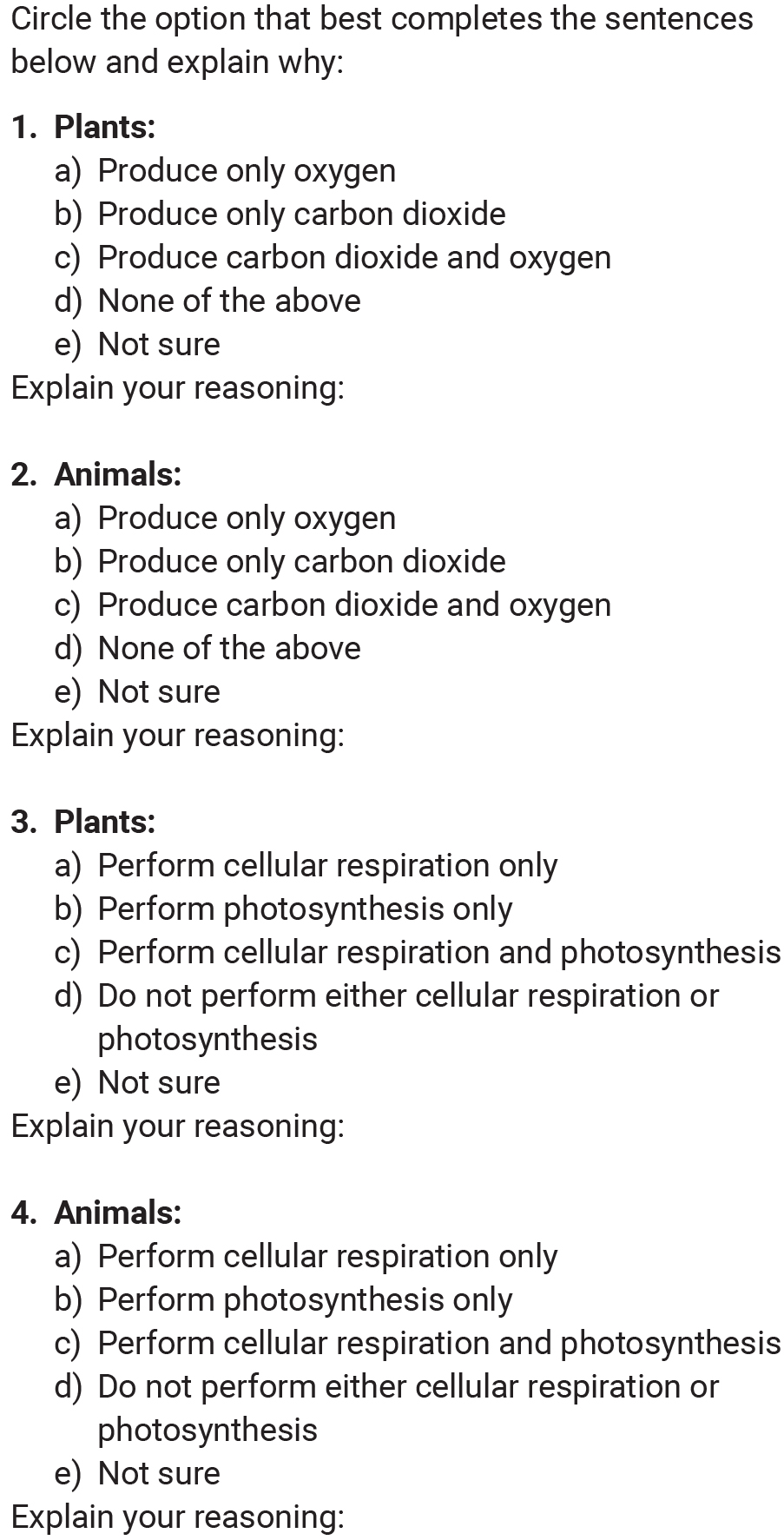
At this point, the goal is not to change their thinking but to help them articulate their current conceptions. After this discussion, we ask a few students to share their responses and explanations with the class. As an explanation for why they selected that plants produce only O2, student responses include, “Plants produce oxygen (O2) and that’s how we get our O2 to breathe” and “They take in CO2 and give off O2.”
As an explanation for choosing that plants perform photosynthesis only, typical student responses include, “Plants can’t perform cellular respiration; only humans do. So the only logical explanation would be photosynthesis” and “They make their own food.” This discussion helps students see the variety of thinking among their classmates, which provides a rationale for further exploration of the topic—if students in the class hold a variety of conflicting ideas and explanations, then how do we know which ideas are scientifically accurate?
Next, students write down everything they know about energy production in animals on the board, and each group has an opportunity to add a new idea or dispute an idea another group suggested. Ideas typically include chemical reactions, ATP production, and mitochondria. Students then review a diagram (Figure 3) and interpret what it means. Responses generally include, “We make energy by breathing O2 in and then doing cellular respiration.”
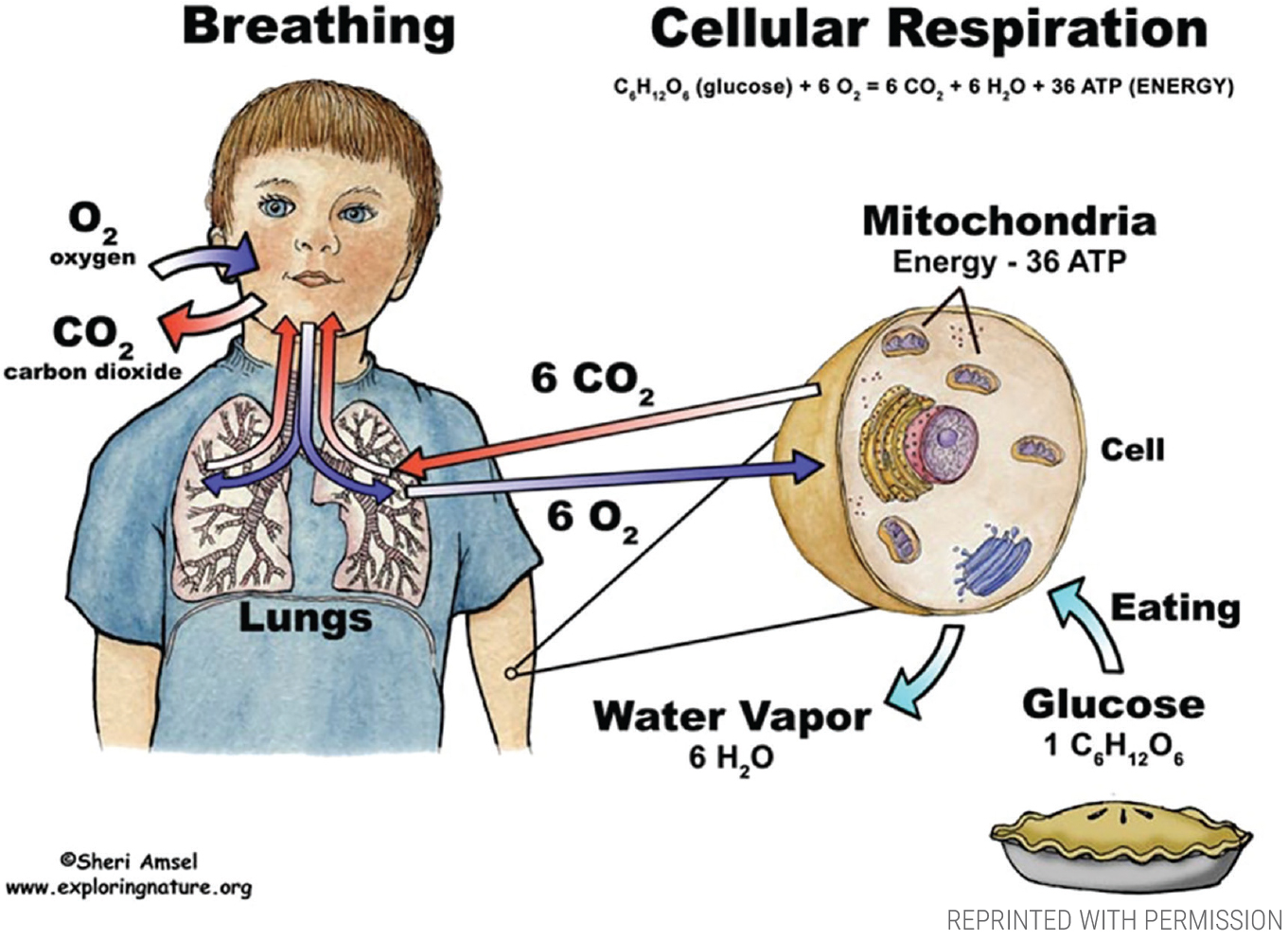
We subsequently pose the research question, “Do plants make energy, and if so, is it any different than the process animals use to make energy?” Students discuss these questions and then we take a class poll (show of hands) of their current thinking: I don’t know Plants do not make energy like animals Plants make energy like animals
Students almost always answer “Plants do not make energy like animals.” This discussion takes about 10 minutes and sets the stage for using a simulation to model cellular respiration and photosynthesis in which both a plant and animal species are present (Figure 4).
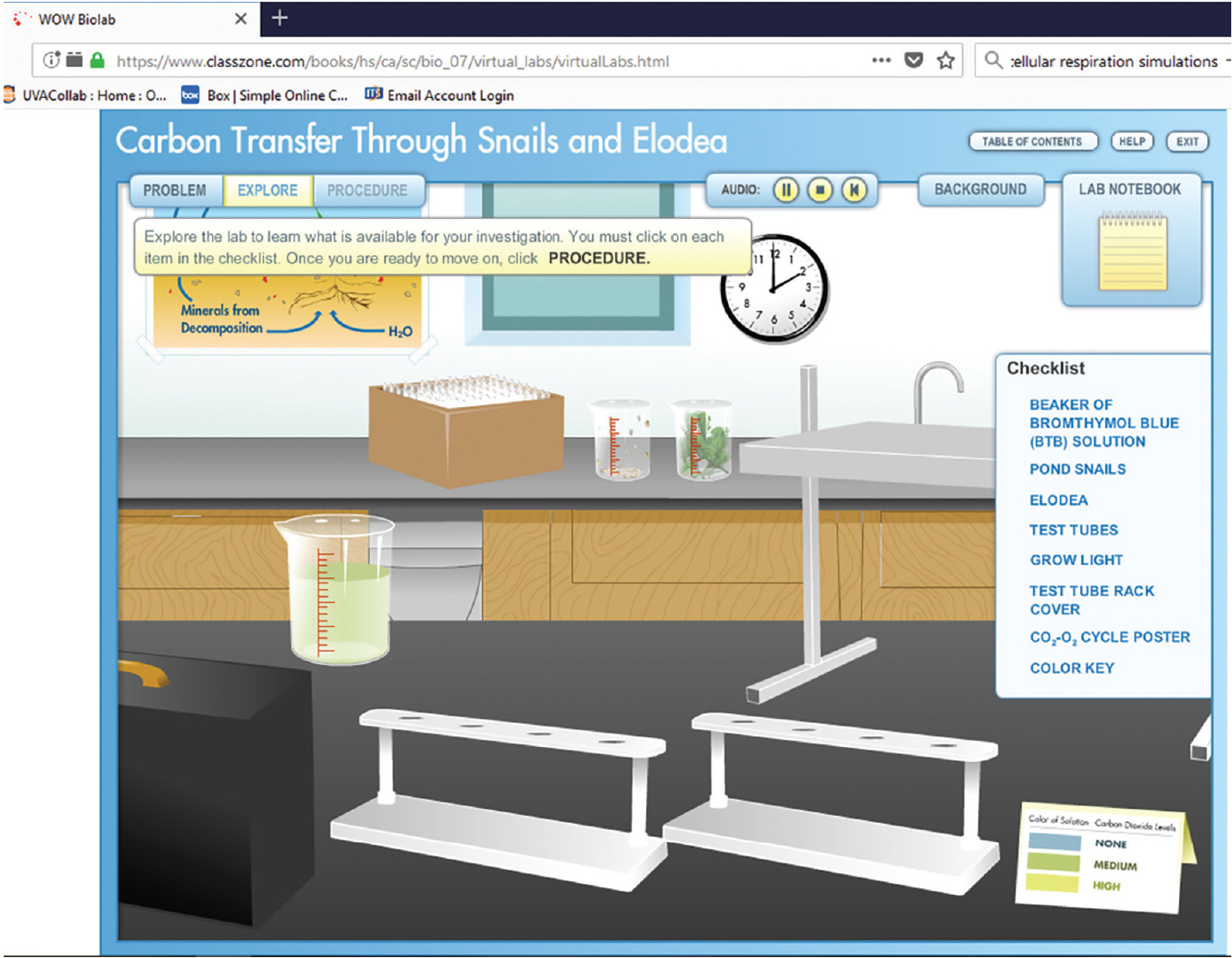
Creating conceptual conflict
This part of the lesson is a modification of a classic hands-on investigation using aquatic Elodea plants and snails that allows students to conduct multiple trials and different iterations of the investigation, while simultaneously reducing material costs and the time required to collect and analyze data. We devote about five minutes to introducing a free simulation (see “On the web”), in which several potential independent variables can be manipulated (e.g., number of snails/Elodea, light conditions) and set the amount of CO2 (indicated by bromothymol blue solution color) as the dependent variable (Figure 5). In addition to pointing out interface components and how to change variables, we explain that bromothymol blue is an indicator solution that changes color depending upon the concentration of CO2, which, in water, forms carbonic acid. We then discuss how the indicator solution will help us answer our research question.
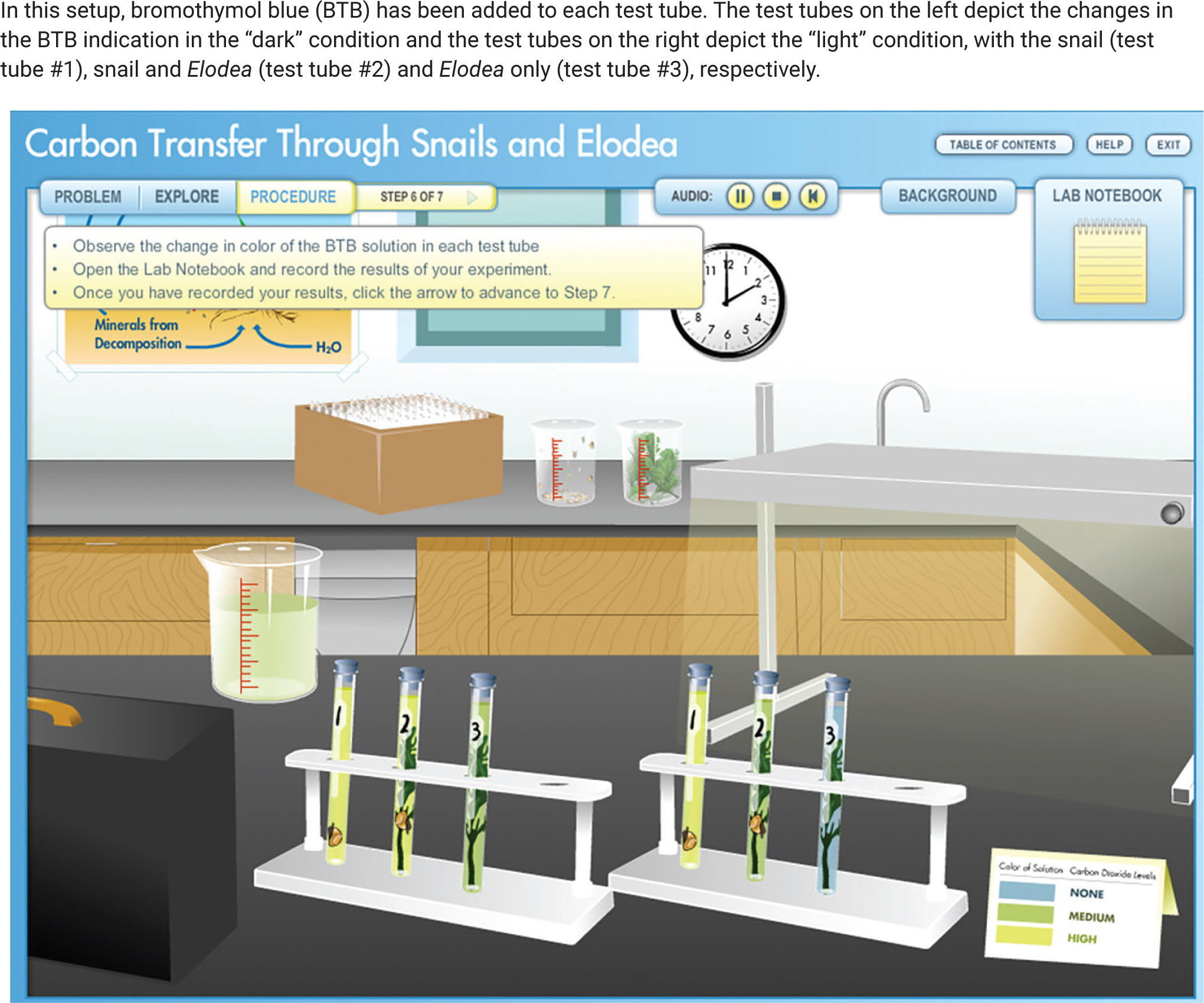
Students have approximately 15 minutes to work in groups of three to develop a hypothesis and design an experiment using the simulation to answer the research question. Computer simulations support conceptual change best when students have the opportunity to test their own hypotheses (Baser 2006). One common hypothesis students make is that, “Plants do not do cellular respiration like animals because they do photosynthesis instead.” Another common one is that “When the lights are on, plants do photosynthesis, and when the lights are off, they do cellular respiration since they can’t photosynthesize in the dark.”
Even though students have been told that the process of transforming energy from chemical potential energy in glucose to chemical potential energy in ATP is called cellular respiration, some students will still hypothesize that, “Plants make energy by photosynthesis instead of cellular respiration” demonstrating the misconception that photosynthesis is the process plants undergo, analogous to cellular respiration in animals. Rarely will students accurately hypothesize that, “Plants do cellular respiration at all times in order to transform the chemical energy needed to perform cell functions.”
After students have set up their experimental design on the handout (see “On the web”), they use the simulation to test their hypothesis. After the groups complete their investigations, record their results, and respond to the analysis and discussion questions (which takes about 15 minutes), we ask one student representative from each group to share their hypothesis and whether or not it was supported.
Sometimes we have only had access to a single computer, so we modify this part of the activity for the entire class. Following experiment design planning, each group shares its hypothesis and proposed investigation. The class votes on one experiment to run. We do not guide them to a specific design, and sometimes they choose a design that will not allow them to answer the question. In this case, when students are analyzing the data as noted below, they may determine that a different experiment is needed to gather more information, which we then set up and run.
Guiding conceptual restructuring
In this step of conceptual change, students evaluate and revise their conceptions based on new data or information. We re-pose the overarching research question to the entire class: “Do plants make chemical energy like animals?” and ask several students to share their thinking using evidence from their experiment (or another group’s experiment) to support their claim. At this point, most of the students have collected data that confirms their initial conceptions: that Elodea perform photosynthesis in the light condition (consuming CO2, producing O2) as evidenced by the blue color of the solution in a test tube that contains only Elodea in the light condition. In addition, they conclude that the snails perform cellular respiration, also in the light condition, as demonstrated by the green/yellow color of the test tube. However, it is common that students did not perform a similar test under dark conditions.
We have found that students overlook this important experimental design element because they are so focused on demonstrating evidence of photosynthesis, which they have learned requires light energy. We ask students if they have conducted the experiment under dark conditions, and if so, what they found. If no one collected this data, we collect it as an entire class.
Students are then challenged to offer an explanation why both the Elodea and snail test tubes turn greenish yellow without light. We ask students, “If the evidence (yellow color, indicating the high amount of carbon dioxide) means the snails are doing cellular respiration, what is a reasonable conclusion about the plants given this same evidence?” Despite the obvious conclusion, that plants do perform cellular respiration, students often are so entrenched in their beliefs that this evidence must be explicitly pointed out to ensure everyone reaches the same normative conclusion.
After we have guided students to the accurate conception that both plants and animals do cellular respiration all of the time, we ask them, “If, at the beginning of the lesson, you thought plants only did photosynthesis, where did you get this idea?” Most often, students respond that they learned it in a prior science class: “When talking about plants, we talk about photosynthesis and when talking about animals, we talk about cellular respiration.” We then point out how important it is for scientists to question ideas and to use evidence to support their claims. We also consider why plants would need chemical energy to move (e.g., tropisms, reaction to stimuli, open/close stomata), grow, and produce complex molecules like cellulose and starch. This discussion takes about 20 minutes.
Finally, we ask them to reconsider the diagram in Figure 1 and ask them how the picture might reinforce the idea that plants only do photosynthesis. Student responses include, “It only shows cellular respiration on the animal part of the diagram and photosynthesis on the plant part of the diagram.” We then pose the question, “What organelle must plants have to do cellular respiration?” and students accurately respond, “mitochondria” and note that this is indeed one of the organelles found in plant cells. Students are often amazed that they never thought more critically about this since they know that plants cells have mitochondria!
As a summative assessment, we use the same four multiple-choice and open-ended explanation questions that students responded to on the pre-assessment and score them using the rubric (see “On the web”). Note that students receive 1 point for each correct multiple-choice response, and then we score the accurate responses and misconceptions holistically across all four explanations.
One potential extension to this activity is for students to vote on one experimental design to set up using actual materials (Elodea and snails) that could be used to verify and reinforce the results of the simulation. Flinn Scientific has a hands-on version of this investigation, in their BioFax!; however, it takes several hours to obtain results and requires several materials, which is why we use the simulation. Students could compare the results of the hands-on investigation against their simulated results the next class period. Another possible extension that would allow for connections to the ELA Common Core State Standards would be to include a writing assignment allowing students to describe their change in thinking.
Conclusion
Overall, we find the conceptual change approach to develop students’ accurate conceptions of the processes of cellular respiration in plants and animals to be highly effective. In our experience, students are motivated to design an experiment to test their hypothesis, and they enjoy using the simulation. They are often shocked upon realizing that the results of their investigations contradict their often long-held misconception that “plants do photosynthesis and animals do cellular respiration.”
The assessment of conceptual change relied primarily on students’ evidence-based rationales for selecting a particular multiple-choice answer. Their post-assessment explanations accurately conveyed that plants engage in the processes of both photosynthesis and cellular respiration. Conceptual change is exemplified by one student’s written post-assessment explanation that demonstrated mastery: “Plants produce CO2 through cellular respiration in the mitochondria and O2 through photosynthesis in the chloroplasts. Animals only do cellular respiration and therefore only produce CO2. Animals do not have chloroplasts.”


